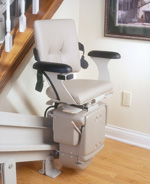Increasing Safety on the Stairs and in the Home
Published by Stephen on September 11, 2009 Under stair liftsIt is important that a person of any age is careful when using the stairs, but frequently diseases and conditions that are more common among seniors can make using the stairs much more difficult and even dangerous.
As a result, the above sixty-five age group is at an increased risk of having a fall while using the stairs. This risks are increased by diseases such as arthritis, which can cause joint pain, and osteoporosis, which results in much weaker bones.
Since the stairs can present so many dangers to a senior or other person who has limited mobility, it is important to attempt to find ways to make using the stairs easier and safer. Some decide simply not to use the stairs at all and avoid them at the cost of ignoring a large section of their home or even moving to an assisted living home. However, this is not very practical and, in the case of moving to a nursing home, represents a very serious life change that can move the senior much further from home and be very costly.
Instead, it is usually preferable to find a means of increasing the accessibility of the staircase, which will allow the senior to safely use it. Many choose to install a stair lift, as this is one of the quickest and least expensive ways of making the staircase easier to use.
Basic Stair Lift Design
 There are a number of different brands and models of stair lifts available, but stair lifts usually share a very similar design. The sitting stair lift, which is also called a stair chair, remains the most common and also the safest type of stair lift available, which is recommended for most people. When using a stair chair, the senior will simply sit down in a chair, which can usually be swiveled away from the staircase to increase safety when transferring into or out of the chair, and be carried up the staircase.
There are a number of different brands and models of stair lifts available, but stair lifts usually share a very similar design. The sitting stair lift, which is also called a stair chair, remains the most common and also the safest type of stair lift available, which is recommended for most people. When using a stair chair, the senior will simply sit down in a chair, which can usually be swiveled away from the staircase to increase safety when transferring into or out of the chair, and be carried up the staircase.
Using a simple hand-control, the senior can completely control the stair chair, while they sit back and enjoy the ride. Seat-belts are included with most models and shoulder straps are also usually available for most stair chairs.
The other type of stair lift is the standing stair lift, or perch lift. As the name implies, the user of a standing stair lift remains standing as they are carried up the staircase, perched atop a small platform. Even though perch lifts do have several handholds and sometimes even a support that can be leaned against, the senior still must stand as they are carried up the stairs, which can be dangerous for seniors with poor balance or limited vision.
Perch lifts are usually only used by those who, for medical reasons, can not use a standard stair chair. This is common after having a knee replacement or hip replacement surgery, which makes bending the legs enough to sit down very difficult. However, for those who do not have a medical need for a perch lift, it is usually strongly recommended against for most elderly people.
No Comments |
Add a Comment